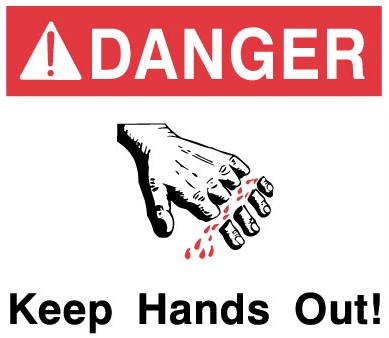Rebecca McLeod is a senior associate of the firm of Preston Russell Law and she wrote a well versed article on what happens when someone gets their fingers mangled in a machine due to a lack of machinery guarding. Although the case was tried under the old HSE Act, not the new HSAW 2015 legislation, it does clearly demonstrate that the courts are not interested in excuses. See: Trouble at t’mill for the full article.
What Happened?
- On the day of the incident the mill had run out of timber so a worker decided to carry out maintenance work on the conveyer system and saw. (Lack of Capacity = Change to ‘Work as Imagined’).
- The worker who was an experienced member of the team decided to lubricated a piece of machinery while it was still running and without a buddy (Normalised Deviance).
- The worker did not properly isolate the machine, although he did switch off the power to the machinery at the main switch, push in the emergency stop button on the control panel and place the “hold card” above the emergency stop signal (Isolation & Lockout Procedural Failure).
- The worker went inside a safety fence and worked near the feed tray of the conveyer system, tightening bolts and carrying out maintenance. He decided to grease the horizontal chains and turned the machinery back on – again a breach of safety policy (Normalised Deviance)
- He placed a rag behind the vertical chain and sprayed lubricant at the moving chain. The chain caught the rag and dragged the rag, and his hand, to a point where the chain meets the sprocket, causing serious injuries to his fingers (Fingers Mangled).
What did WorksafeNZ say?
WorkSafe claimed that the Mill had failed to put in place three safety measures by:
- Failing to ensure a guard covered the vertical chain and sprocket; and
- Failing to cordon off the machinery area with a secure fence; and
- Failing to ensure that the curtain light system turned off the machinery when someone entered the area around the machine.
What did the District Court say?
The district court judge found that because the machinery was unguarded on the day, it was not even necessary for the machinery to be running for the Company to have failed to take all practical steps to ensure the safety of their workers.
- There needed to be a guard over the chain and sprocket; and,
- Without a sufficient fence guarding the machinery or a system which turned the machinery off when someone entered the area, there was a reasonably foreseeable risk.
Fine: $40,000.
What did the High Court say? (In short…. Your Appeal #Failed… sort out your machinery guarding)
- The Mill argued that oiling the vertical sprocket was not part of the workers normal maintenance tasks therefore they could not have reasonably anticipated the lubricating of the vertical chain and sprocket as it was not something he had ever done before and that the worker had never breached a safety procedure before.
- The High Court dismissed the appeal; in essence the charge under section 6 could have been made out on any day, given the lack of guard on the vertical chain and sprocket.
- The High Court reminded the company that even trusted and experienced employees could foreseeably take short cuts and fail to use common sense when working on machinery.
What can you do?
If you have whirring bits of machinery on your site:
- Make sure they meet guarding requirements and have Emergency Stops (see WorkSafeNZ Best Practice Guidelines for the Safe Use of Machinery)
- Have standard operating procedures (SOP) / safe work procedures (SWP) for how to use and maintain the machinery. This needs to include how to complete isolation and lock out procedures for electrical, mechanical and pneumatic energy.
- Regularly test the e-stops and guards to check they are working
- Check that your workers are trained and supervised appropriately
- If you want to know what WorkSafeNZ Inspectors are looking for when they walk around your workshop or factory go to Manufacturing inspectors assessment toolkits
Have a safe and productive week and make sure your machinery guarding is fully functioning,
SB
